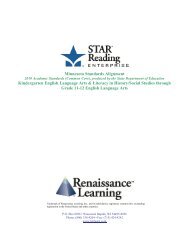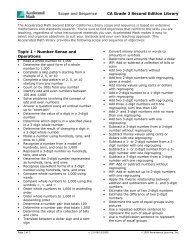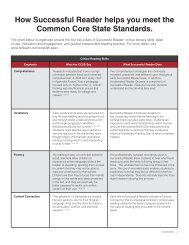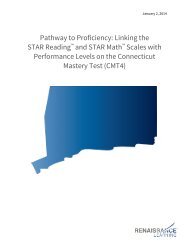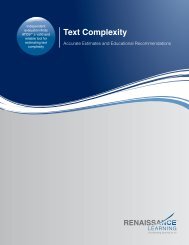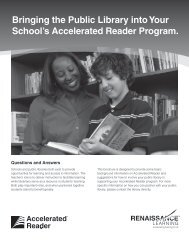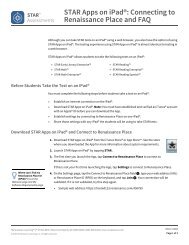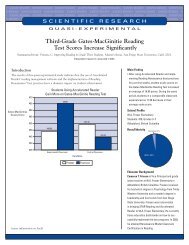Technical Manual - Renaissance Learning
Technical Manual - Renaissance Learning
Technical Manual - Renaissance Learning
You also want an ePaper? Increase the reach of your titles
YUMPU automatically turns print PDFs into web optimized ePapers that Google loves.
NormingDevelopment of Norms for STAR Early Literacy Test ScoresThe second step in the norming process was to randomly select at each grade anequal-sized sample of students from each of ten deciles of student achievementperformance; this sample of 134,830 students, each with a fall and a spring testrecord, constituted the final norming sample. To avoid any potential bias in thesample selection, the spring decile of student performance for the matchedsample was used in creating the ten decile student achievement performancegroups. This step insured that the norming process was appropriate for studentswithin each of ten decile achievement performance groups and to reduce theeffects of sample selection bias.The third step in the norming process was a post-stratification weightingprocedure to ensure that the randomized matched student’s grade and decilenorming sample was adjusted to match a US nationally representative sample.There were three key sample stratification variables used in the norming process:geographic region (Northeast, Southeast, Midwest, and West), socioeconomicstatus (low SES, below-median SES, above-median SES, and high SES), and schoolsize (< 200 students, 200–499 students, and 500+ students).The post-stratification process allowed sample adjustments with all possiblecombinations of three key stratification variables for geographic regions (4groups) socioeconomic status (4 groups) and school size (3 groups) for a total of 48combinations of the stratification groups. Specific post-stratification weights werespecified for each of the 48 combinations of the stratification groupings to allowthe stratification grouping to match the US national population percentages.Geographic region. Using the categories established by the National Centerfor Education Statistics (NCES), students were grouped into four geographicregions as defined below: Northeast, Southeast, Midwest, and West.NortheastConnecticut, District of Columbia, Delaware, Massachusetts, Maryland,Maine, New Hampshire, New Jersey, New York, Pennsylvania, RhodeIsland, VermontSoutheastAlabama, Arkansas, Florida, Georgia, Kentucky, Louisiana, Mississippi,North Carolina, South Carolina, Tennessee, Virginia, West VirginiaMidwestIowa, Illinois, Indiana, Kansas, Minnesota, Missouri, North Dakota,Nebraska, Ohio, South Dakota, Michigan, WisconsinWestAlaska, Arizona, California, Colorado, Hawaii, Idaho, Montana, NewMexico, Nevada, Oklahoma, Oregon, Texas, Utah, Washington, WyomingSTAR Early Literacy<strong>Technical</strong> <strong>Manual</strong>101





